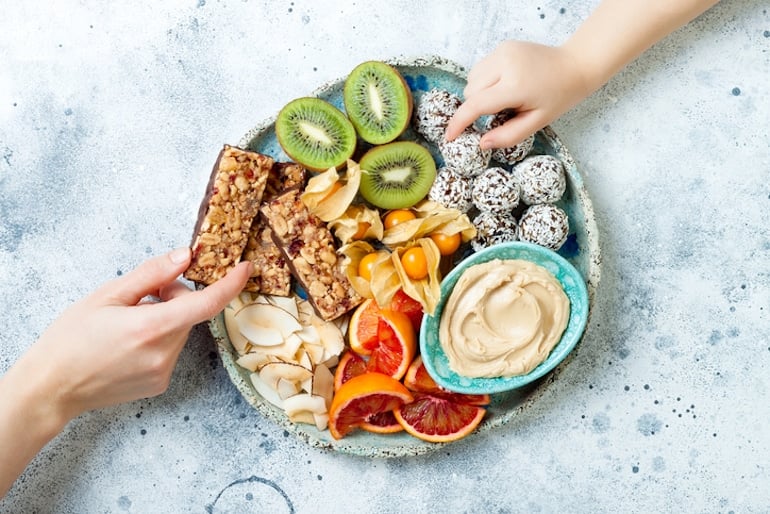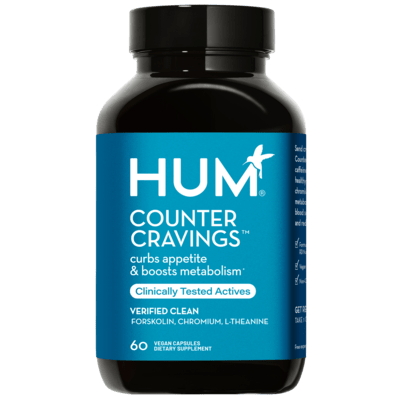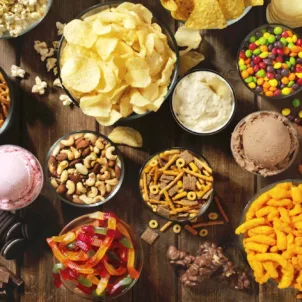THE WELLNEST • Food • Healthy Eating
An RD Explains How to Finally Beat Sugar Cravings
By Gaby Vaca-Flores, RDN, CLE •
March 3, 2020
Gaby Vaca-Flores, RDN, breaks down the three parts of your brain that contribute to your “need” to eat sugar. Plus: Learn how to beat sugar cravings with four dietitian-approved healthy lifestyle hacks.
Picture this: It’s the middle of the day and the chocolate bar in the vending machine is calling your name. We’ve all been there! Sugar cravings are incredibly common, and giving in to them is one of the easiest ways to compromise an otherwise healthy lifestyle.
While it may feel impossible at times to beat sugar cravings, there are some tried-and-true hacks that can help ease your sweet tooth. But first, let’s start by understanding how sugar cravings connect to the source of all willpower: the brain.

Sugar and the Brain
There are three main parts of the brain that play important roles in how we respond to sugar cravings: the hippocampus, the caudate nucleus, and the insula.Hippocampus
The hippocampus controls short- and long-term memory, motivation, and emotion—all of which are reinforcing factors in reward-motivated behavior. So how does this all translate to sugar cravings? The hippocampus helps you remember how good sugar makes you feel, and the strength of this memory can drive you to continue to seek pleasure with continuous consumption.Caudate Nucleus
On the other hand, we have the caudate nucleus. This part of the brain also plays a role in the reward circuit, but its main responsibility is to help us form and sustain habits. If you experience sugar cravings at the same time each day—or even each time you enter a movie theatre, for example—the caudate nucleus helps form this type of conditioned response.Insula
The insula contributes to cravings by creating emotional responses to sensory experiences. Think about the feeling you might get when you see an ice cream commercial on a hot summer day. The joy and longing associated with such a scenario often indicates that the insula is activated.How to Beat Sugar Cravings
By now, it may feel like we’re programmed to yearn for sweets based on our brain’s mechanisms. So does this mean that reducing cravings is a hopeless endeavor? Absolutely not! Among other lifestyle efforts, balancing our daily nutrition habits can play an even bigger role in helping us take back control. The next time you’re thinking of reaching for something sweet, refer to this go-to guide to beat sugar cravings:1. Eat a well-balanced diet
Frequently giving in to sugar cravings can have negative health consequences. Excess sugar can lead to eating too many calories and thus obesity, a major risk factor for most chronic diseases. One of the best ways to reduce sugar cravings is to eat a varied diet packed with complex carbohydrates, lean protein, healthy fats, and unlimited greens. Following a nutritionally balanced lifestyle not only leaves plenty of room for the occasional sweet treat, but it can also help lower risks related to high-sugar diets. Eating a balanced diet doesn’t have to be bland, either. In many cases, you can find healthy swaps for your favorite sweets. Trying new recipes—such as these no-bake vegan brownies—can help make reducing sugar cravings so much easier!
2. Snack smarter
Consider snacks as your second line of defense against a sweet tooth. Even with a balanced diet, it’s common to still want a tasty treat between meals. The trick is to have healthy snacks ready to go to prevent reaching for unhealthy alternatives. Also, pay special mind to snacks that are advertised as sugar-free or artificially sweetened. Research suggests that our brains respond the same way to artificial sweeteners as they do regular sugar, meaning they can support cravings rather than fight them. Instead, steer clear of processed foods and try snacking on whole foods that are naturally sweet in flavor, such as berries and dark chocolate. Also, adding high-protein snacks can also help keep you satisfied between meals. A cup of yogurt sweetened with blueberries, a few dates, a hard-boiled egg, or a handful of trail mix are all quick and nutritious snack options.3. Keep Sugary Foods Out of Reach
Remember: The brain is conditioned to give in to cravings. One of the best ways to recondition the mind to no longer want sugar is to make it harder to feel rewarded by it. In other words, if you really want that sweet treat, you’d have to work for it. But how? Research shows that we’re more susceptible to giving in to cravings and overeating when unhealthy foods are easily accessible. So set yourself up for success by keeping sugary treats out of the pantry and off your grocery list. You might find that the inconvenience spurred by lack of availability may be enough to make you forget about your sugar craving. This strategy can also help you stick to your balanced diet and healthy snacks.4. Take Control of the 3 S’s
Stress. Sleep. Sweat. These three lifestyle factors can either heighten sugar cravings or help take the edge off.Stress
According to a 2018 study, people who experience elevated stress levels are more motivated to engage in reward-seeking behavior. You can practice de-stressing activities such as spending time outdoors, meditating, and reading to help ease the frequency of and your response to sugar cravings. Additionally, keeping a food journal to record your thoughts and events throughout the day may also help identify stressors that trigger your cravings.Sleep
Getting enough sleep is easier said than done. But research suggests that sleep deprivation can cause disruptions in our brain profiles, which can then lead to craving higher-calorie foods. Sleeping less than your daily recommended hours can also pave the way for low energy levels, making it difficult to manage stress and plan for balanced meals. Establishing a consistent, relaxing bedtime routine is one of the best ways to start getting more restful sleep and effectively beat sugar cravings.Sweat
Exercise your willpower! There are countless benefits of working out, one of them being that regular physical activity can help strengthen your resistance to cravings. Another study shows that a five-minute walk per hour can significantly reduce the onset of food cravings between meals. Simply put, there’s no reason to not get moving.More like this









